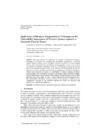Identificador persistente para citar o vincular este elemento:
https://accedacris.ulpgc.es/jspui/handle/10553/76244
| Campo DC | Valor | idioma |
|---|---|---|
| dc.contributor.author | Rocco S., Claudio M. | en_US |
| dc.contributor.author | Salazar A., Daniel E. | en_US |
| dc.contributor.author | Zio, Enrico | en_US |
| dc.date.accessioned | 2020-12-02T14:19:18Z | - |
| dc.date.available | 2020-12-02T14:19:18Z | - |
| dc.date.issued | 2009 | en_US |
| dc.identifier.issn | 0973-1318 | en_US |
| dc.identifier.other | Scopus | - |
| dc.identifier.uri | https://accedacris.ulpgc.es/handle/10553/76244 | - |
| dc.description.abstract | This paper presents the application of advanced computational techniques developed by the authors for evaluating the vulnerability characteristics of network systems exposed to harmful events. The physical system is modeled as a network (graph) of nodes interconnected by links. Uncertainties on the propagation and effects of an attack are modeled by probability distributions on the times of propagation through the network links and the numbers of people affected at the network nodes reached by the hazard. The impact of an attack is quantified by simulating the propagation of the hazard through the network nodes and links, by means of a combination of cellular automata and Monte Carlo simulation. The vulnerability assessment is embedded within a systematic multiple-objective optimization analysis aimed at identifying the optimal protective scheme which minimizes the average impact in terms of entities affected and hazard propagation time. The vulnerabilities and relative protection schemes of two networks of realistic size are systematically analyzed by the proposed approach for testing the procedure and identifying its strengths and weaknesses. © RAMS Consultants Printed in India. | en_US |
| dc.language | eng | en_US |
| dc.relation.ispartof | International Journal of Performability Engineering | en_US |
| dc.source | International Journal of Performability Engineering[ISSN 0973-1318],v. 5 (1), p. 71-84, (Abril 2009) | en_US |
| dc.subject | 3306 Ingeniería y tecnología eléctricas | en_US |
| dc.subject | 120710 Redes de flujo | en_US |
| dc.subject.other | Distributed Networks | en_US |
| dc.subject.other | Monte Carlo Simulation | en_US |
| dc.subject.other | Vulnerability Assessment | en_US |
| dc.title | Application of advanced computational techniques to the vulnerability assessment of network systems exposed to uncertain harmful events | en_US |
| dc.type | info:eu-repo/semantics/Article | en_US |
| dc.type | Article | en_US |
| dc.identifier.scopus | 64549130025 | - |
| dc.contributor.authorscopusid | 7004508307 | - |
| dc.contributor.authorscopusid | 56240751500 | - |
| dc.contributor.authorscopusid | 7005289082 | - |
| dc.description.lastpage | 84 | en_US |
| dc.identifier.issue | 1 | - |
| dc.description.firstpage | 71 | en_US |
| dc.relation.volume | 5 | en_US |
| dc.investigacion | Ingeniería y Arquitectura | en_US |
| dc.type2 | Artículo | en_US |
| dc.utils.revision | Sí | en_US |
| dc.date.coverdate | Abril 2009 | en_US |
| dc.identifier.ulpgc | Sí | en_US |
| dc.contributor.buulpgc | BU-DER | en_US |
| item.fulltext | Con texto completo | - |
| item.grantfulltext | open | - |
| Colección: | Artículos | |
Citas SCOPUSTM
1
actualizado el 08-jun-2025
Visitas
70
actualizado el 25-ene-2025
Descargas
53
actualizado el 25-ene-2025
Google ScholarTM
Verifica
Comparte
Exporta metadatos
Los elementos en ULPGC accedaCRIS están protegidos por derechos de autor con todos los derechos reservados, a menos que se indique lo contrario.
